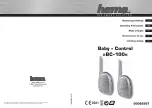
62
I²C-bus autosync deflection controller for PC monitors
TDA4857
The formulae for R
HBUF
also takes into account the voltage
swing across this resistor:
Ù
805
0.8
HBUFpar
R
HREF
R
HBUFpar
R
HREF
R
HBUF
R
=
×
−
×
=
PLL1 phase detector
The phase detector is a standard type using switched cur-
rent sources, which are independent of horizontal
frequency. It compares the middle of horizontal sync with a
fixed point on the oscillator sawtooth voltage. The PLL1
loop filter is connected to HPLL1 (pin 26).
See also Section “Horizontal position adjustment and
corrections”.
Horizontal position adjustment and corrections
Alinear adjustment of the relative phase between the hori-
zontal sync and the oscillator sawtooth (in PLL1 loop) is
achieved via register HPOS. Once adjusted, the relative
phase remains constant over the whole frequency range.
Correction of pin unbalance and parallelogram is achieved
by modulating the phase between oscillator sawtooth and
horizontal flyback (in loop PLL2) via registers HPARAL and
HPINBAL. If those asymmetric EW corrections are per-
formed in the deflection stage, both registers can be dis-
connected from the horizontal phase via control bit ACD.
This does not change the output at pin ASCOR.
Horizontal moire cancellation
To achieve a cancellation of horizontal moire (also known
as ‘video moire’), the horizontal frequency is divided-by-
two to achieve a modulation of the horizontal phase via
PLL2. The amplitude is controlled by register HMOIRE. To
avoid a visible structure on screen the polarity changes with
half of the vertical frequency.
Control bit MOD disables the moire cancellation function.
PLL2 phase detector
The PLL2 phase detector is similar to the PLL1 detector
and compares the line flyback pulse at HFLB (pin 1) with
the oscillator sawtooth voltage. The control currents are
independent of the horizontal frequency. The PLL2 detec-
tor thus compensates for the delay in the external hori-
zontal deflection circuit by adjusting the phase of the HDRV
(pin 8) output pulse.
An external modulation of the PLL2 phase is not allowed,
because this would disturb the pre-correction of the hori-
zontal focus parabola.
Soft start and standby
If HPLL2 is pulled to ground, either by an external DC cur-
rent or by resetting register SOFTST, the horizontal output
pulses and B+ control driver pulses will be inhibited. This
means that HDRV (pin 8) and BDRV (pin 6) are floating in
this state. In both cases PLL2 and the frequency-lock loop
are disabled, and CLBL (pin 16) provides a continuous
blanking signal and HUNLOCK (pin 17) is floating.
This option can be used for soft start, protection and power-
down modes. When pin HPLL2 is released again, an auto-
matic soft start sequence on the horizontal drive as well as
on the B-drive output will be performed.
A soft start can only be performed if the supply voltage for
the IC is a minimum of 8.6V.
The soft start timing is determined by the filter capacitor at
HPLL2 (pin 30), which is charged with a constant current
during soft start. In the beginning the horizontal driver stage
generates very small output pulses. The width of these
pulses increases with the voltage at HPLL2 until the final
duty cycle is reached. The voltage at HPLL2 increases fur-
ther and performs a soft start at BDRV (pin 6) as well. After
BDRV has reached full duty cycle, the voltage at HPLL2
continues to rise until HPLL2 enters its normal operating
range. The internal charge current is now disabled. Finally
PLL2 and the frequency-locked loop are activated. If both
functions reach normal operation, HUNLOCK (pin 17)
switches from the floating status to normal vertical blanking,
and continuous blanking at CLBL (pin 16) is removed.
Output stage for line drive pulses [HDRV (pin 8)]
An open-collector output stage allows direct drive of an in-
verting driver transistor because of a low saturation volt-
age of 0.3V at 20mA. To protect the line deflection transistor,
the output stage is disabled (floating) for a low supply volt-
age at Vcc.
The duty cycle of line drive pulses is slightly dependent on
the actual horizontal frequency. This ensures optimum drive
conditions over the whole frequency range.
Summary of Contents for MultiSync 75F-3
Page 56: ...DDC Flow Chart 53 ...
Page 57: ...Master I C Flow Chart 54 ...
Page 58: ...Master I C restart mode Flow Chart 55 ...
Page 59: ...Slave I C Flow Chart 56 ...
Page 61: ...BLOCK DIAGRAM I C bus autosync deflection controller for PC monitors TDA4857 58 ...
Page 71: ...I C bus autosync deflection controller for PC monitors TDA4857 68 APPLICATION INFORMATION ...
Page 77: ...74 8 Monolithic triple 13 5nS CRT driver ...
Page 78: ...75 ...
Page 79: ...76 ...
Page 80: ...77 ...
Page 102: ......
Page 103: ......
Page 104: ......
















































